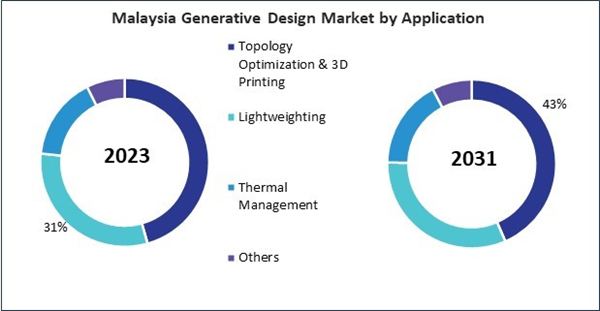The China market dominated the Asia Pacific Generative Design Market by Country in 2023, and would continue to be a dominant market till 2031; thereby, achieving a market value of $72.18 millions by 2031. The Japan market is registering a CAGR of 19.7% during 2024-2031. Additionally, the India market would capture a CAGR of 21.4% during 2024-2031.
The adoption of generative design is accelerating across various industries, driven by its ability to offer substantial performance, efficiency, and innovation benefits. Generative design is being adopted across various industries with solutions tailored to specific sector needs. For instance, in aerospace, generative design is used to optimize lightweight structures, while in automotive, it is applied to enhance crashworthiness and performance parts. This industry-specific adoption allows companies to leverage generative design's unique capabilities to solve sector-specific challenges.
Generative design is increasingly integrated into academic curricula across engineering and design programs. Educational institutions are incorporating generative design tools and principles into their coursework, preparing the next generation of engineers and designers to use these advanced technologies. Universities and research institutions are adopting generative design for student projects and research initiatives, driving innovation and exploration in design methodologies.
China's growth in high-tech manufacturing, including precision engineering and high-tech machinery, directly benefits from generative design. The ability to create optimized, complex parts with minimal material waste aligns with the demands of precision engineering, enhancing the performance and efficiency of manufacturing processes. According to the State Council of the People's Republic of China, the output of China's high-tech manufacturing sector increased by 8.7 percent year on year in the first half of 2024. The rise of smart manufacturing in China, characterized by the integration of IoT and AI, benefits from generative design’s advanced capabilities. Moreover, the “Made in China 2025” initiative aims to advance China’s manufacturing capabilities and promote innovation in high-tech industries. The increasing use of robotics in high-tech manufacturing drives the demand for generative design technologies in China. Thus, the expansion of the automotive industry and rising high-tech manufacturing output in the region are driving the market's growth.
List of Key Companies Profiled
- PTC, Inc.
- Dassault Systemes SE
- Autodesk, Inc.
- Siemens AG
- ANSYS, Inc.
- nTopology Inc.
- Hexagon AB
- Altair Engineering, Inc. (IMG Companies, LLC)
- Carbon, Inc.
- Synera GmbH
Market Report Segmentation
By Deployment
- On premise
- Cloud
By Industry
- Automotive
- Industrial Manufacturing
- Aerospace & Defense
- Architecture & Construction
- Others
By Application
- Topology Optimization & 3D Printing
- Lightweighting
- Thermal Management
- Others
By Country
- China
- Japan
- India
- South Korea
- Singapore
- Malaysia
- Rest of Asia Pacific
Table of Contents
Companies Mentioned
- PTC, Inc.
- Dassault Systemes SE
- Autodesk, Inc.
- Siemens AG
- ANSYS, Inc.
- nTopology Inc.
- Hexagon AB
- Altair Engineering, Inc. (IMG Companies, LLC)
- Carbon, Inc.
- Synera GmbH
Methodology

LOADING...









